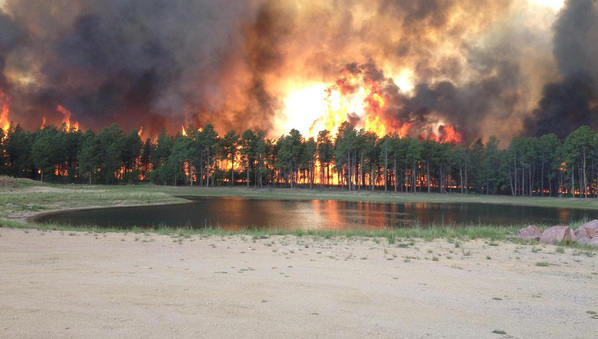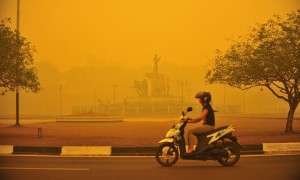

Deep in a jungle far, far away, one of the biggest man-made ecological crises to ever arise is currently occurring. With scenes reminiscient of Dante’s Inferno or the 1992 Gulf War, the skyline is filling with a thick and acrid smoke that is creating an ecological disaster the world can no longer ignore.
Those of you familiar with the Rainforest Action Network advert where an orangutan uses sign language to tell a girl about the impact her favorite foods may already have some level of awareness of the damage that palm oil can wreak. It seems so far away, these strange and beautiful creatures living in verdant forests. It’s a shame, yes, but it’s so far removed from our every-day reality of going to the office, gym and back that it’s easy to put it all to the backs of our minds and just go about our day as normal.
That is until the victim is you.
Every single year for the more than 20 years, farmers and businesses throughout Indonesia have been burning their lands instead of using more sustainable methods for clearing land. And why not, it’s easier and more profitable than spending the time to do it manually, right? All you need is a match and a little bit of lighter fluid and you can clear hundreds of acres in a day.
But, at what cost? Every single year a greedy few in Indonesia have been gifting the rest of the world with the release of colossal amounts of greenhouse gas, but….profits matter more than that, right?
2015 will go down in history as the worst on record. Since September the emissions coming from fires in Indonesia (15 to 20 million tons) have exceeded the daily emissions of the entire U.S. economy (14 million tons). Emissions over a three-week period are also already higher than the total annual CO2 emissions of Germany, except these fires began in July and have been raging for months. Yet, mainstream media has people focused on a handful of cars manufactured by Volkswagen.
Unfortunately, wildlife can’t give nice sound-bites or schedule press conferences. And, regardless it is still too early to tell the effect this year’s burning season will have on the wildlife in Indonesia, but you can rest assured that it will be significant. Fortunately, some people are starting to raise their voices. In the worst hit areas, stories are emerging of babies being born and dying within weeks of everything from respiratory failure to infections caused from exposure to the toxic fumes. These poor children spending their short few days on this planet audibly gasping for clean air has finally gotten the attention of the world’s leaders. With over 500,000 people suffering from haze-related respiratory infections in Indonesia alone, it’s a problem even the most corrupt government officials can’t ignore any longer. With schools being closed four times this year in Kuala Lumpur alone, it’s a problem that is quite literally blowing in the wind, and it’s blowing right through the air conditioning vents of government officials who have thus far resisted calls to crack down on farmers using torches to clear cut their land.
Of course, you’re probably thinking, “It’s Asia’s problem….” It’s normal to feel this way secure thousands of miles across the lapping waves of the vast Pacific…but air currents travel and particulates from Indonesian burns are being detected along America’s West Coast. This is a man-made, annual festival of greed wherein a few people with torches decide to light up great tracts of land in what has been labelled “a crime against humanity,” simply in order to boost their profits. Even with mounting public outrage, calls for new legislation, and the threat of enforcing existing penalties…well, these have done little to stop these companies, because…..profits.
So now, sitting in your armchair in the West, breathing your clean air and perhaps looking at the fiery pictures on TV and feeling terrible about the situation, remember with the rising sea-levels, the prevalence of super-storms, and recent record-breaking meteorological events such as Joaquin and Patricia, this issue is now, quite literally, coming to knock at your door. And, if you don’t let it in, no worries…it’ll simply come in through the air filters on your house.
So how do you take action against a problem so vast and complex?
So far, the Singaporean government have made great efforts to track down offenders in order to issue them with fines. In October 2015, Greenpeace released figures showing that Asia Pulp and Paper is the company responsible for setting the most fires. This is despite their products carrying a (now suspended) “Singapore Green Label” for sustainable practices. Singaporean supermarkets were also swift to take action and banned APP immediately. Their products were rather unceremoniously tossed from the shelves of most major supermarkets in Singapore.
But it is not just paper manufacturers to blame for the crisis as a lot of these fires also come from palm oil concessions. Unfortunately, due to its versatility and low price, an astonishing array of products contain palm oil. From the food in your pantry, to your shampoo in the bathroom, and the sweet smelling concoction you mop the floor with, palm oil seems to be everywhere.
Studies by various consumer groups have shown that, even when you buy products bearing a “Green Palm’ sticker, a lack of clarity within the supply chain means that the ingredients may still have been procured from a smaller vendor who utilizes ecologically disastrous farming methods. The best palm oil, it would seem, is no palm oil at all.
Isolating palm oil as an ingredient is not an easy task. Due to allergies, companies legally only have to declare by name three different types of oil on the ingredients list: peanut, sesame and soy bean oil. Palm oil can hide under any of its 220+ different monikers, which means many manufacturers don’t list it at. If you are buying food products, however, palm oil is a saturated fat, so if the ingredients boast no saturated fat, then that product is also palm-oil free. It’s a handy tip to keep in mind the next time you head off to the grocery store.
But, what if you simply cannot find a version of a certain product that has no palm oil? Cheyenne Mountain Zoo has created “Palm Oil,” a simple to use app that lets you search by company name and product so you can check which have the best track-record when it comes to their ecological policies. I was relieved to discover that I can still stuff myself silly on Ben and Jerry’s and enjoy as many warm cups of Swiss Miss as I like during the festive period, but when my current stash runs out I should probably refrain from purchasing any more L’Oreal or Kiehls products and make a switch to Aveeno or Neutrogena instead; the latter of which are entirely free of palm oil.
If one of your favorite brands happens to be showing poor ratings for sustainability, the app even provides a sample letter you can download to send to the company questions asking them to consider revising their environmental policy. *Cough “Whole Foods” Cough*
The Palm Oil Investigations Group is another app that has you covered. Their app will actually let you scan individual bar codes and let you know which products are a better choice for you, as well as for the planet. Put simply, the simplest of economics is at play here. The fires were started for no reason other than profit. They thought that the cost of the burning outweighed the cost of the negative impact; fortunately, technology has a cheap solution that can hlep keep them in check.
Government legislation has already been introduced, but as this year’s record-breaking fires show, it is not acting as a strong enough deterrent. Providing proof of exactly who started the fires, to allow for meaningful prosecution, is a thorny and difficult issue that will not resolve itself soon. However, by cutting consumer demand for the products that are being produced by these serial eco-offenders, you can hit them where it hurts; right in the wallets.
Really, it comes down to consumers letting these companies know that while we enjoy using their products, their annual burning brings a negative impact we don’t find anywhere near as appealing.













